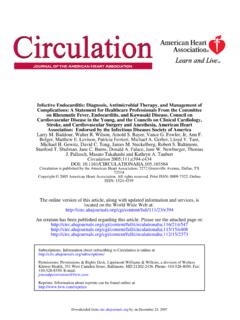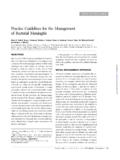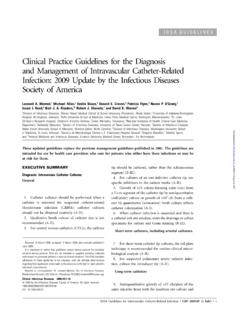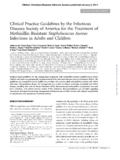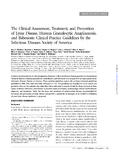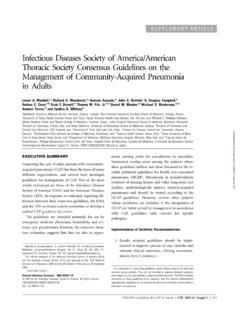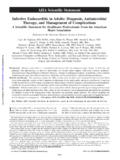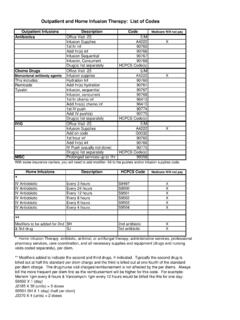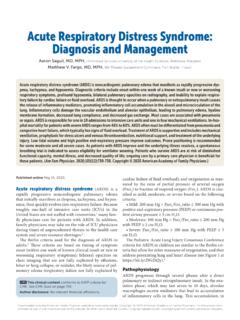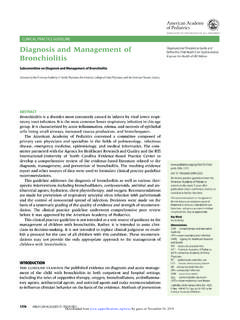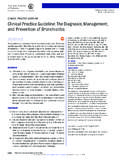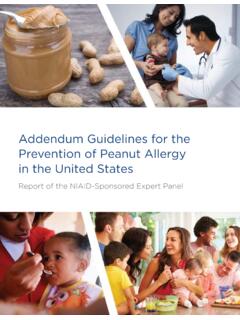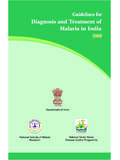Transcription of Guidelines for the Prevention and Treatment of ...
1 Guidelines for the Prevention and Treatment of Opportunistic Infections in Adults and Adolescents with HIVR ecommendations from the Centers for disease Control and Prevention ,the National Institutes of Health, and the HIV Medicine Association of the infectious Diseases society of AmericaHow to Cite the Adult and Adolescent Opportunistic Infection Guidelines :Panel on Opportunistic Infections in Adults and Adolescents with HIV. Guidelines for the Prevention and Treatment of opportunistic infections in adults and adolescents with HIV: recommendations from the Centers for disease Control and Prevention , the National Institutes of Health, and the HIV Medicine Association of the infectious Diseases society of america . Available at Accessed (insert date)[include page numbers, table number, etc. if applicable]It is emphasized that concepts relevant to HIV management evolve rapidly.
2 The Panel has a mechanism to update recommendations on a regular basis, and the most recent information is available on the AIDS info website ( ).Access AIDS infomobile siteGuidelines for the Prevention and Treatment of Opportunistic Infections in Adults and Adolescents with HIV iWhat s New in the GuidelinesUpdates to the Guidelines for the Prevention and Treatment of Opportunistic Infections in Adults and Adolescents with HIVThe Guidelines for the Prevention and Treatment of Opportunistic Infections in Adults and Adolescents with HIV document is published in an electronic format that can be easily updated as relevant changes in Prevention and Treatment recommendations editors and subject matter experts are committed to timely changes in this document because so many health care providers, patients, and policy experts rely on this source for vital clinical changes are developed by the subject matter groups listed in the document (changes in group composition are also promptly posted).
3 These changes are reviewed by the editors and by relevant outside reviewers before the document is altered. Major revisions within the last 6 months are as follows:May 26, 20201. Candidiasis (Mucocutaneous): The Panel updated the text, Treatment , pregnancy considerations, references, and Treatment table and made the following key changes: Added important new information on spontaneous abortion in pregnant women after any exposure to fluconazole (low even single-dose or high exposure). Added a brief discussion on the gentian violet topical application randomized clinical trial for oral candidiasis and updated the Treatment table. Added a statement indicating that azole resistance can be seen in vulvovaginal candidiasis caused by non-C. albicans species. Added details for the use of boric acid in azole-refractory C. glabrata vaginitis in the Treatment table.
4 2. Herpes Simplex Virus: The Panel updated references throughout the section and improved the readability of the text. In addition, the Panel made the following key changes: Updated information about the seroprevalence of HSV-1 and HSV-2 in the United Addressed HSV-1 as a cause of genital herpes. Provided additional information about the interpretation of type-specific HSV serologic assays. Updated information about Prevention methods for HSV-2 infection. Updated information about Treatment of acyclovir-resistant HSV 11, 20201. Table 8. Summary of Pre-Clinical and Human Data on, and Indications for, Opportunistic Infection Drugs During Pregnancy: The Panel updated this table to include the following key changes: Information on several new drug combinations for hepatitis C Treatment have been added, including dasabuvir/ombitasvir/paritaprevir/ritona vir, elbasvir/grazoprevir, glecaprevir/pibrentasvir, ombitasvir/paritaprevir/ritonavir, sofosbuvir/velpatasvir, and sofosbuvir/velpatasvir/voxilaprevir.
5 Data on the use of these new drugs in pregnancy are limited but they can be used if the benefit is felt to outweigh the potential risks. However, ribavirin is contraindicated during pregnancy so regimens including ribavirin should not be used in pregnant for the Prevention and Treatment of Opportunistic Infections in Adults and Adolescents with HIV ii Information on isavuconazole, a new oral antifungal, has been added. Use in pregnancy is not recommended. Information on rifapentine has been added. Given malformations and fetal loss noted in animal studies, use of alternate drugs for tuberculosis Treatment and prophylaxis in pregnancy are recommended. Guidelines for the Prevention and Treatment of Opportunistic Infections in Adults and Adolescents with HIV ivTable of ContentsWhat s New in the Guidelines ..iIntroduction ..A-1 Bacterial Enteric Infections ..B-1 Bartonellosis.
6 C-1 Candidiasis (Mucocutaneous) ..D-1 Chagas disease ..E-1 Coccidioidomycosis ..F-1 Community-Acquired Pneumonia ..G-1 Cryptococcosis ..H-1 Cryptosporidiosis ..I-1 Cystoisosporiasis ..J-1 Cytomegalovirus disease ..K-1 Hepatitis B Virus Infection ..L-1 Hepatitis C Virus Infection ..M-1 Herpes Simplex Virus disease ..N-1 Histoplasmosis ..O-1 Human Herpesvirus-8 disease ..P-1 Human Papillomavirus disease ..Q-1 Leishmaniasis ..R-1 Malaria ..S-1 Microsporidiosis ..T-1 Mycobacterium avium Complex disease ..U-1 Mycobacterium tuberculosis Infection and disease ..V- 1 Pneumocystis Multifocal Leukoencephalopathy/JC Virus Infection ..X-1 Syphilis ..Y- 1 Talaromycosis (Penicilliosis) ..Z-1 Toxoplasma gondii Encephalitis ..AA-1 Varicella-Zoster Virus Diseases ..BB-1 Tables Table 1. Prophylaxis to Prevent First Episode of Opportunistic disease ..CC-1 Table 2. Treatment of AIDS-Associated Opportunistic Infections (Includes Recommendations Guidelines for the Prevention and Treatment of Opportunistic Infections in Adults and Adolescents with HIV vfor Acute Treatment and Chronic Suppressive/Maintenance Therapy).
7 CC-7 Table 3. Recommended Doses of First-Line Drugs for Treatment of Tuberculosis in Adults and Adolescents ..CC-30 Table 4. Indications for Discontinuing and Restarting Opportunistic Infection Prophylaxis in HIV-Infected Adults and Adolescents ..CC-32 Table 5. Significant Pharmacokinetic Interactions between Drugs Used to Treat or Prevent Opportunistic Infections ..CC-35 Table 6. Common or Serious Adverse Reactions Associated with Systemically Administered Drugs Used to Treat Opportunistic CC-50 Table 7. Dosing Recommendations for Drugs Used to Treat or Prevent Opportunistic Infections That Require Dosage Adjustment in Patients with Renal CC-56 Table 8. Summary of Pre-Clinical and Human Data on, and Indications for, Opportunistic Infection Drugs During Pregnancy ..CC-62 Figure: Immunization Schedule for Human Immunodeficiency Virus (HIV)-Infected Adults ..DD-1 Appendix A.
8 List of Abbreviations ..EE-1 Appendix B. Panel Roster and Financial for the Prevention and Treatment of Opportunistic Infections in Adults and Adolescents with HIV A-1 Introduction (Last updated May 29, 2018; last reviewed June 26, 2019)Opportunistic infections (OIs) were the first clinical manifestations that alerted clinicians to the occurrence of the acquired immunodeficiency syndrome (AIDS). Pneumocystis pneumonia (PCP), toxoplasma encephalitis, cytomegalovirus (CMV) retinitis, cryptococcal meningitis, tuberculosis, disseminated Mycobacterium avium complex (MAC) disease , and pneumococcal respiratory disease , as well as certain cancers such as Kaposi sarcoma and central nervous system lymphoma, have been hallmarks of AIDS. These OIs, and many more, occurred on average 7 to 10 years after infection with ,2 Until effective antiretroviral therapy (ART) was developed, patients generally survived only 1 to 2 years after the initial manifestation of OIs have been defined as infections that are more frequent or more severe because of HIV-mediated Starting in the late 1980s, the use of chemoprophylaxis, immunization, and better strategies for managing OIs improved quality of life and lengthened survival of persons with Early antiretroviral drugs and Treatment strategies added further However, the introduction of highly effective combination ART in the mid-1990s has had the most profound influence on reducing OI-related morbidity and mortality in persons with the availability of multiple safe, effective, and simple ART regimens, and a corresponding steady decline in the incidence of OIs,11 the Centers for disease Control and Prevention (CDC)
9 Estimates that more than 40% of Americans with HIV are not effectively virally As a result, OIs continue to cause preventable morbidity and mortality in the United Achieving and maintaining durable viral suppression in all people with HIV, and thus preventing or substantially reducing the incidence of HIV related OIs, remains challenging for three main reasons: Not all HIV infections are diagnosed, and once diagnosed many persons have already experienced substantial immunosuppression. CDC estimates that in 2015, 15% of the people with HIV in the United States were unaware of their Among those with diagnosed HIV, more than 50% had had HIV for more than 3 years20 and approximately 20% had a CD4 T lymphocyte (CD4) cell count <200 cells/mm3 (or <14%) at the time of ,21 Not all persons with diagnosed HIV receive timely continuous HIV care or are prescribed ART.
10 CDC estimates that in 2015, 16% of persons with newly diagnosed HIV had not been linked to care within 3 months and among persons living with HIV only 57% were adequately engaged in continuous Not all persons treated for HIV achieve durable viral suppression. CDC estimates that in 2014, only 49% of diagnosed patients were effectively linked to care and had durable viral Causes for the suboptimal response to Treatment include poor adherence, unfavorable pharmacokinetics, or unexplained biologic ,24 Thus, some persons with HIV infection will continue to present with an OI as the sentinel event leading to a diagnosis of HIV infection or present with an OI as a complication of unsuccessful viral suppression. Durable viral suppression eliminates most but not all OIs. Tuberculosis, pneumococcal disease , and dermatomal zoster are examples of infectious diseases that occur at higher incidence in persons with HIV regardless of CD4 count.
